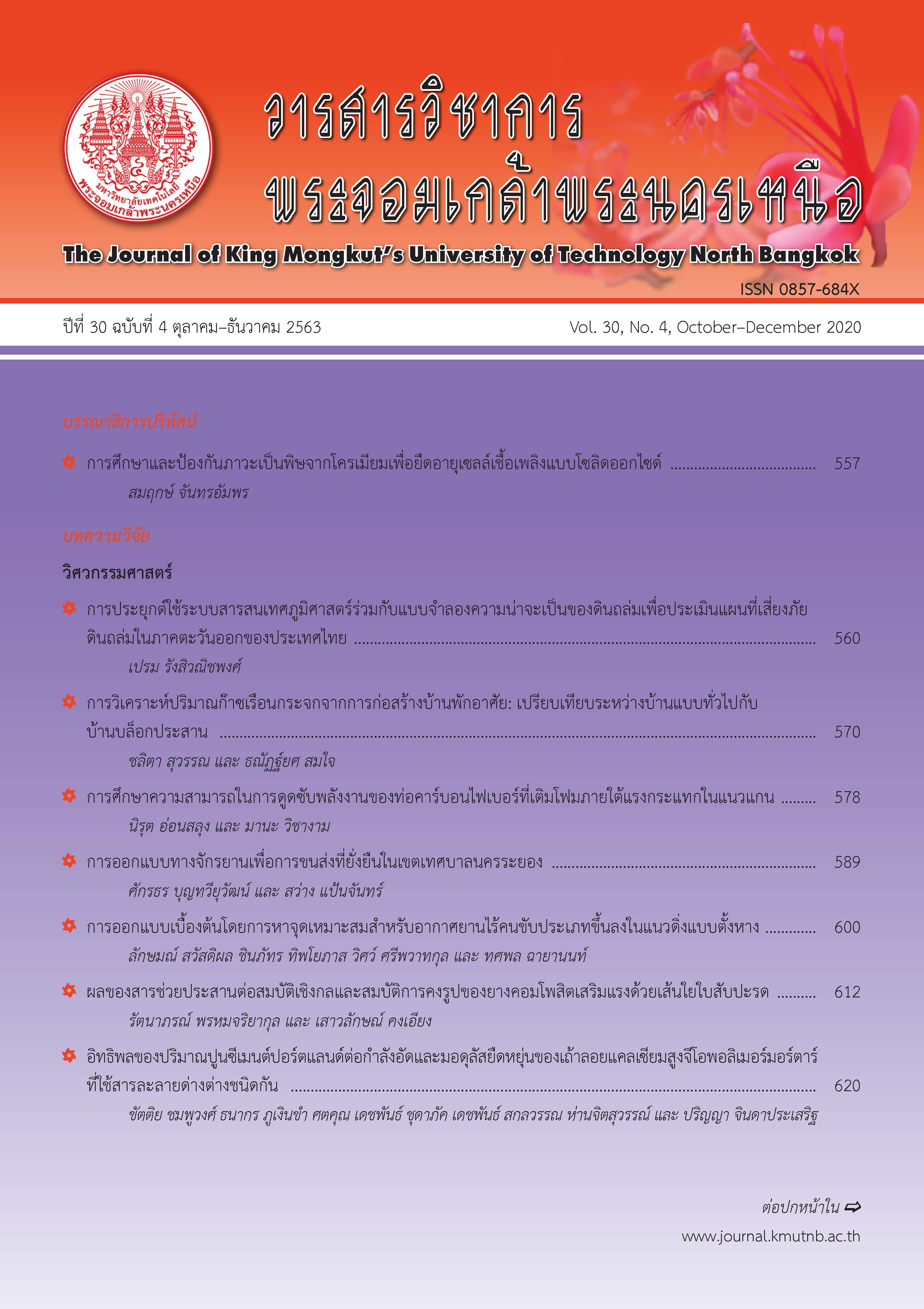การพัฒนาระบบเพาะเลี้ยงสาหร่ายขนาดเล็กในบ่อระบบน้ำวนกลางแจ้งด้วยระบบการหมุนเวียนน้ำ
Main Article Content
บทคัดย่อ
การเพาะเลี้ยงสาหร่ายขนาดเล็ก Ankistrodesmus sp. BPR1102 แบบแบตซ์ และแบบกึ่งต่อเนื่องในบ่อระบบน้ำวนที่มีใบพัดกวนน้ำกลางแจ้งด้วยระบบการหมุนเวียนน้ำ โดยทำการบำบัดน้ำที่ผ่านการเก็บเกี่ยวชีวมวลสาหร่ายแล้วนำมาหมุนเวียนใช้ใหม่ โดยใช้อาหารสูตรปรับปรุง ทำการเพาะเลี้ยงเป็นระยะเวลา 20 วัน พบว่า ในการเพาะเลี้ยงแบบแบตซ์สาหร่ายมีความหนาแน่นเซลล์สูงสุด 448×104 เซลล์ต่อมิลลิลิตร และมีอัตราการเติบโตจำเพาะสูงสุด 0.67 ต่อวัน และจากการเพาะเลี้ยงแบบกึ่งต่อเนื่องที่มีการเติมอาหารใหม่ และนำเซลล์ออกตลอดเวลา ในระหว่างการทดลองได้แปรผันอัตราการเจือจาง ระหว่าง 0.50–0.77 ต่อวัน พบว่า การเพาะเลี้ยงด้วยอัตราการเจือจางต่ำ 0.50 ต่อวัน มีความหนาแน่นเซลล์สูงสุด 344×104 เซลล์ต่อมิลลิลิตร และการเพิ่มอัตราการเจือจางส่งผลให้ความหนาแน่นของเซลล์สาหร่ายลดลง โดยเมื่อปรับอัตราการเจือจางเพิ่มขึ้นเป็น 0.77 ต่อวัน พบว่า สาหร่ายมีความหนาแน่นเฉลี่ยลดลงเหลือ 109×104 เซลล์ต่อมิลลิลิตร แต่เมื่อพิจารณาอัตราผลผลิต พบว่า ที่ระดับอัตราการเจือจาง 0.57 ต่อวัน จะให้อัตราผลผลิตเซลล์สูงสุดที่ 263×104 เซลล์ต่อมิลลิลิตรต่อวัน หรือเท่ากับ 463 มิลลิกรัมต่อลิตรต่อวัน (น้ำหนักแห้ง) สำหรับปริมาณไขมันของสาหร่ายที่เพาะเลี้ยงแบบกึ่งต่อเนื่องมีค่าเฉลี่ยเท่ากับ 22% (น้ำหนักแห้ง) และอัตราผลผลิตไขมันเฉลี่ยเท่ากับ 2,032 มิลลิกรัมต่อลิตรต่อวัน
Article Details
บทความที่ลงตีพิมพ์เป็นข้อคิดเห็นของผู้เขียนเท่านั้น
ผู้เขียนจะต้องเป็นผู้รับผิดชอบต่อผลทางกฎหมายใดๆ ที่อาจเกิดขึ้นจากบทความนั้น
เอกสารอ้างอิง
[2] M. A. Quader and S. Ahmed, “Bioenergy with carbon capture and storage (BECCS): Future prospects of carbon-negative technologies,” in Clean Energy for Sustainable Development. Elservier, 2017, pp. 91–140.
[3] L. Christenson and R. Sims, “Production and harvesting of microalgae for wastewater treatment, biofuels, and bioproducts,” Biotechnology Advances, vol. 29, no. 6, pp. 686–702, 2011.
[4] L. Brennan and P. Owende, “Biofuels from microalgae-A review of technologies for production, processing, and extractions of biofuels and co-products,” Renewable and Sustainable Energy Reviews, vol. 14, no. 2, pp. 557–577, 2010.
[5] Oilgae, Comprehensive Oilgae Report Energy from Algae : Products, Market, Processes & Strategies. India: Tamilnadu, 2013.
[6] Y. Christi, “Raceways-based production of algal crude oil,” in Microalgal Biotechnology: Potential and Production. De Gruyter, 2012, pp. 115–146.
[7] A. Richmond, “Outdoor mass culture of microalgae,” in CRC Handbook of Microalgae Mass Culture. Boca Raton. Florida: CRC Press, 1986, pp. 285–329.
[8] M. A. Borowitzka, “Culturing microalgae in outdoor ponds,” in Algal Culturing Techniques. China: Elservier, 2005, pp. 205–218.
[9] J. A. V. Costa and M. G. Morais, “An open pond system for microalgal cultivation,” in Biofuels from Algae. Elservier, 2014, pp. 1–22.
[10] D. Xiaodong, L. Yajun, and F. Xiaowen, “A promising feedstock for biodiesel,” African Journal of Microbiology Research, vol. 3, no. 13, pp. 1008–1014, 2009.
[11] Y. Peerapornpisal, Freshwater Algae in Thailand, 2nd ed. Chiang Mai: Department of biology, Faculty of science, Chiang Mai University Textbook Publishing Center, 2013 (in Thai).
[12] A. Vonshak, “Laboratory techniques for the cultivation of microalgae,” in CRC Handbook of Microalgae Mass Culture. Boca Raton, Florida: CRC Press, 1986, pp. 117–145.
[13] R. Y. Stanier, R. Kunisawa, M. Mandel, and B. G. Cohen-Bazire, “Purification and properties of unicellular blue green algae (Order Chroococcales),” Bacteriology Reviews, vol. 35, no. 2, pp. 171–205, 1971.
[14] M. Okauch and K. Kawamura, “Optimum medium for large-scale culture of Tetraselmis tetrathele,” Hydrobiologia, vol. 358, pp. 217–222, 1997.
[15] A. Richmond and E. W. Becker, “Technological aspects of mass cultivation-A general outline,” in CRC Handbook of Microalgae Mass Culture. Boca Raton, Florida: CRC Press, 1986, pp. 245–263.
[16] E. G. Bligh and W. J. Dyer, “A rapid method of total lipid extraction and purification,” Journal of Biochemistry and Physiology, vol.37, no. 8, pp. 911–917, 1959.
[17] Standard Method for the Examination of Water and Wastewater, American Public Health Association, 2012.
[18] J. E. Bailey and D. F. Ollis, Biochemical Engineering Fundamental, 2nd ed. Singapore: McGraw-Hill, 1986.
[19] C. Paliwal, T. Ghosh, and S. Mishra, “Effects of different media composition, light intensity and photoperiod on morphology and physiology of freshwater microalgae Ankistrodesmus falcatus – A potential strain for bio-fuel production,” Bioresource Technology, vol. 171, pp. 367–374, 2014.
[20] P. D, Álvarez-Díaz, J. Ruiz, Z. Arbib, J. Barragán, C. Garrido-Pérez, and J. A. Perales, “Lipid production of microalga ankistrodesmus falcatus increased by nutrient and light starvation in a two-stage cultivation process” Appl Biochem Biotechnol, vol. 174, no. 4, pp. 1471–1483, 2014.
[21] L. Xin, H. Hong-ying, G. Ke, and S. Ying-Xue, “Effects of different nitrogen and phosphorus concentrations on the growth, nutrient uptake, and lipid accumulation of a freshwater microalga Scenedesmus sp,” Bioresource Technology, vol. 101, no. 14, pp. 5494–5500, 2010.

